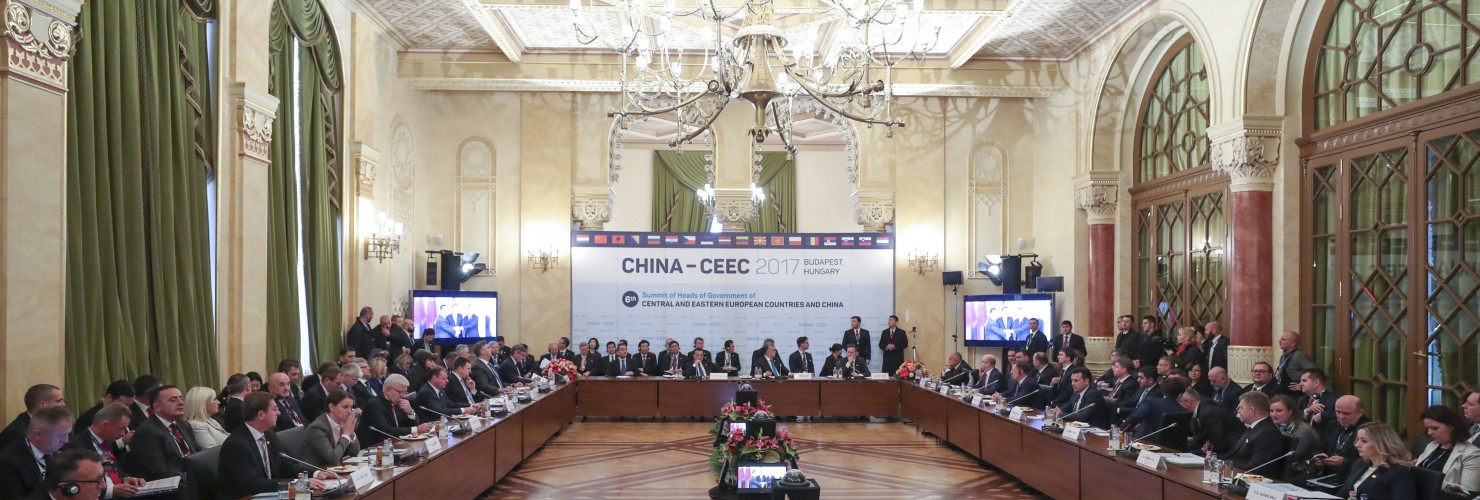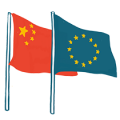

EU-China Opinion Pool: The future of 17+1 after Lithuania's departure
Should I stay or should I go?
The departure of Lithuania from the 17+1 China-Central and Eastern Europe (CEE) cooperation in May showed the format’s existential crisis. During the summit in February it was already clear that several CEE member states were questioning the benefit of the framework.
Still, several CEE states responded positively to Beijing’s diplomatic counter-offensive in late May. During visits from Politburo member Yang Jiechi to Slovenia and Croatia and Foreign Minister Wang Yi’s meetings with Hungarian, Polish and Serbian counterparts in Guiyang, CEE member states voiced their commitment to maintaining China-CEE cooperation.
In this round of our EU-China opinion pool, we have asked several experts from fellow institutions and MERICS to debate the question:
“Is it more in the interest of Central and Eastern European member states to leave or to remain in the 17/16+1 format?”
Plamen Tonchev
Head of Asia Unit at the Institute of International Economic Relations in Greece

Central and Eastern Europe is anything but a homogeneous region, hence the variety of opinions on relations with China.
Lithuania’s exit from the 17+1 format has shown that the Baltic states prioritize political values that China couldn’t care less for, as well as security challenges that China cannot cater to. Romania, too, appears to share this view to a large extent. At the other end of the CEE spectrum, particularly in the Western Balkans, countries badly need foreign investment in infrastructure and domestic industry in order for them to catch up with other parts of Europe, which explains – partly, at least – why they pin their hopes on cooperation with China.
By and large, there is disenchantment among CEE countries, as amply illustrated by the tepid mood at the last summit of the grouping in February 2021. But it would be far-fetched to assume that Chinese authorities would give up on this format, into which Beijing has invested considerable political capital. China has already launched a counterattack masked as a charm offensive with improved inducements. Nor should one expect that many CEE governments would opt for a headlong clash with Beijing.
Ultimately, the stance of individual CEE countries towards 17/16+1 will be conditioned by their self-interest and perceptions of the benefits to be drawn – or not – from cooperation with China. Therefore, an answer as straightforward as possible would be the title of Luigi Pirandello’s 1917 drama Così è, se vi pare! (So It Is, If You Think So).
Ivana Karásková
Founder and project leader of MapInfluenCE, and of China Observers in Central and Eastern Europe (CHOICE)

When considering the option of staying or leaving, the CEE governments should take not only ideological, but also tactical elements of the situation into account. CEE members of 17/16+1 did not enter the platform out of deep affection for China or ideological affinity towards its regime, but as a result of hard-nosed economic expectations of Chinese investment. However, over the years the expectations have mostly not materialized. Moreover, China proved to be a problematic partner. It occasionally threatened with retaliation and targeted CEE countries with hybrid operations or disinformation. Growing military cooperation between Beijing and Moscow have triggered yet another alarm. In another context, the countries got tired of being painted as a Chinese “Trojan horse” due to their participation in the grouping.
Yet the format has one undeniable – if largely paradoxical – advantage: Due to the collective, region-wide nature of the platform, it attracts the attention of other influential external players, from Washington through Brussels to Berlin. By highlighting possible “hijacking” of the region by China, the CEE countries, which may otherwise be treated as an uneventful periphery, get elevated to a higher level of international relevance. The presence of a problematic external player also stimulates a more mature discussion on national interests in the CEE countries.
The “zombie format” of 17/16+1 may bring little economic benefits to the members of the grouping. On the other hand, the format could not only leverage CEE status in the eyes of their Chinese counterparts, but also improve the countries’ bargaining position vis-a-vis their allies in the West.
Una Bērziņa-Čerenkova
Head of the Asia program at the Latvian Institute of International Affairs

The loud Lithuanian exit was caused by several value-related scandals and China's assertive communication, but the deeper disappointment over 17+1 is shared across the region. Therefore, it would be in the Latvian and Estonian interest to jointly distance themselves from the grouping, albeit perhaps picking a less abrasive approach than that of Lithuania, e.g., by leaving, but with statements to communicate and soften the move.
In the Baltic case, the leading motivation to join 16+1 was economic diversification. From the offset, the three Baltic states avoided political buy-ins or dependencies in the form of infrastructure loans. But the cooperation failed to meet the initial economic expectations of exports, FDI and transit increase. On top of that, the few successful projects, e.g., China's Didi Chuxing investment in the Estonian ride-sharing company Taxify in 2017, were concluded bilaterally, and branded as a 17+1 outcome post-hoc. Also, the deteriorating China-US relationship and the increasing recognition of security challenges posed by China in the West is forcing the Baltics to pick a side, and the allies are an obvious choice.
Whether this reasoning stands for all the diverse members of the 17/16+1 format, however, is hard to say, as CEE is not a uniform grouping, neither is it a region – in contrast to China’s perception.
Ágnes Szunomar
Senior Research Fellow at Institute of World Economics in Budapest and Associate Professor at Corvinus University of Budapest
For CEE countries (CEECs), the idea of strengthening relations with China came either around the early 2000's or after the global economic crisis of 2008, in order to enhance economic development and catching-up processes. That is, CEECs' relationship building with China has been motivated mainly by economic interest at that time. Results of such bilateral cooperation, however, failed to match CEECs' expected benefits since they couldn't attract major amounts of Chinese investments, while increasing trade volumes meant mainly increasing exports from China, with growing trade deficit for many CEECs.
As a result, by the time China initiated the 16+1 platform CEECs were already divided over the preferable extent of engagement with China: Some countries had reservations about a growing Chinese presence in the region while others welcomed the resulting (other-than-economic) opportunities. By that time, CEEC’s motivations were already mixed, with economic rationale being just one driving factor. As the platform hasn't proved to be an engine for economic benefits for CEECs but helped China to gain foothold in other terrains, some have become disappointed or even suspicious. By contrast, countries where economic rationale hasn't been the sole motivating factor continued to insist on the importance of the relationship even amidst US and EU pressure as well as potential security concerns.
As reasons for engaging with China differs within the CEE region, future decisions to stay or to leave may also differ depending on the aforementioned rationale. Consequently, those countries favorably disposed to China will definitely stay while those critical of China and more receptive to various Western actors' concerns may leave the format.
Jan Weidenfeld
Director Policy and Advisory at MERICS

In Berlin, officials have always been rather skeptical about the idea that the economic interests of the CEE countries would be served by the 17/16+1 format. They might have felt increasingly vindicated in recent years: CEE EU member states have not seen significant upticks in Chinese inbound investments, and most have recorded mounting trade deficits. In the German public eye, the construction of a motorway funded by Chinese loans that has catapulted Montenegro into historic debt has become emblematic of the economic (and political) downsides the 16+1 format has created for participating European countries.
Initial German government concerns about the negative effects that 17/16+1 format could have on EU cohesion have mostly subsided. Unlike only a few years ago, 17/16+1 is no longer on top of the agenda of German policy-makers when they offer their take on the challenges that bedevil European China policy. They are now concerned with a different 17/16+1 question altogether: Would it be in the interest of the EU and Germany if the CEE EU member states were to leave the 17/16+1 format?
The prevailing answer these days is: No, it would not. Berlin has no interest in the 17/16+1 format collapsing and becoming another thorny issue on what is already a difficult EU-China agenda. Rather, German officials seem content with the status quo: The 17/16+1 format fails to live up to China’s economic promises, while becoming a high-level venue for the display of souring CEE-China political relations – and perhaps even a lasting failure of Chinese diplomacy in a region of considerable strategic importance to Germany.
Grzegorz Stec
EU-China Analyst at MERICS

Lithuania’s departure is unlikely to trigger an exodus of other CEE member states from the format. Even though the format’s performance has been underwhelming, the tangible incentives to leave it altogether are limited.
At large, the format has failed to facilitate the much-anticipated intensification of economic ties with China. Chinese investments in CEE member states remain scarce and trade imbalance in direct relations with China has worsened. However, many CEE member states benefit from being suppliers for German exporters to China. Still, the format grants otherwise scarcely available face time with Chinese leadership and remains a political instrument amplifying the otherwise modest relevance of CEE member states in discussions on China in Brussels or Washington.
What do CEE member states stand to gain from leaving the format? On one hand, their exodus would not necessarily imply a move towards a more united EU27+1 approach. A political momentum for such a project has diminished since the abandoned idea of the Leipzig summit. On the other, the participation in the 17/16+1 helps the CEE member states to attract involvement from Washington eager to counter China – be it in the form of cybersecurity cooperation or support for regional infrastructure projects such as the Three Seas Initiative. All the while, the departure would come at a cost of straining relations with Beijing.
The exact strategic calculations will surely differ within the diverse group of CEE member states. However, given that Beijing remains committed to keeping the format alive and CEE member states have little incentives to leave it, the 17/16+1 format is likely to linger on without causing a splash.

